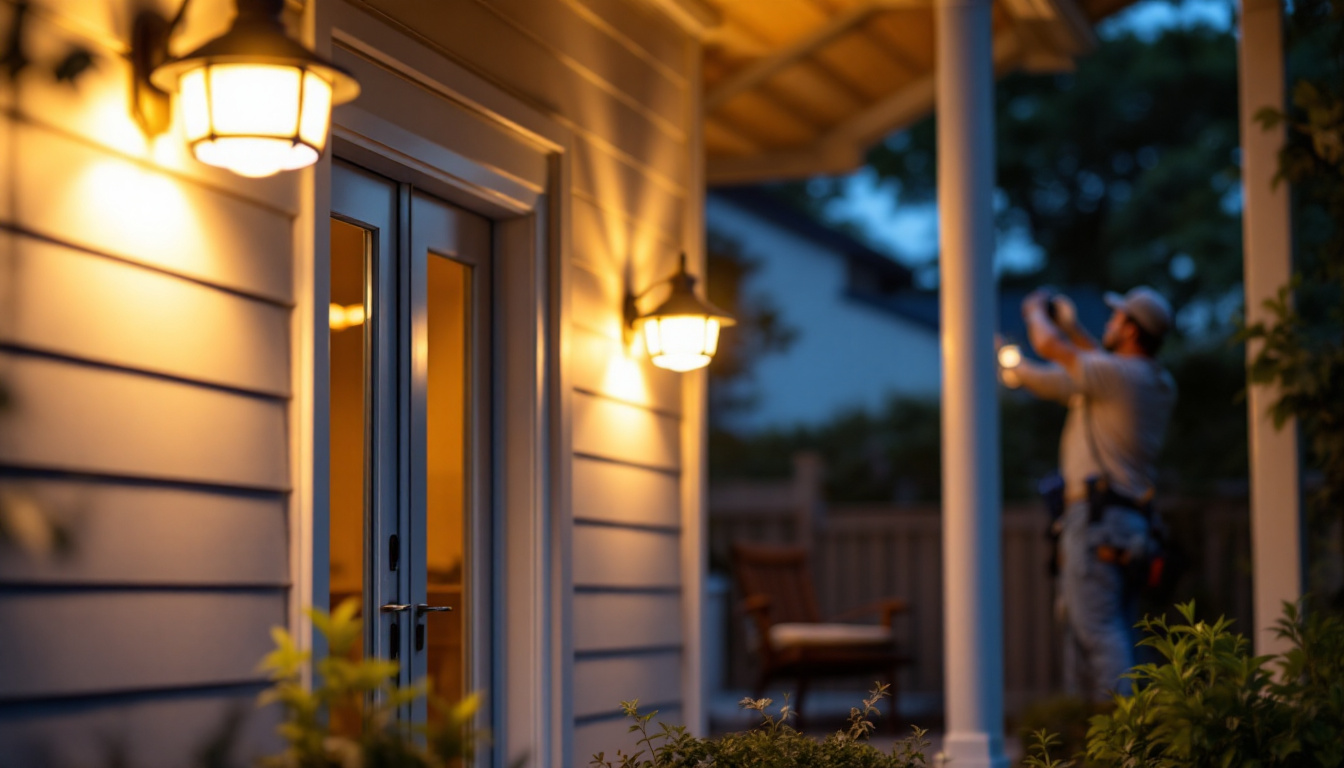
As urban landscapes evolve, the demand for effective and aesthetically pleasing lighting solutions continues to grow. Electric lamp posts play a pivotal role in this transformation, serving not only as functional elements but also as integral components of urban design. For lighting contractors, understanding the nuances of electric lamp posts is essential for delivering high-quality installations that meet both client expectations and regulatory standards.
Electric lamp posts are more than just sources of illumination; they are vital components of public infrastructure. These fixtures come in various designs, materials, and technologies, each serving different purposes and environments. From traditional street lighting to modern smart poles, the evolution of lamp posts reflects advancements in technology and changing urban needs.
There are several types of electric lamp posts, each designed for specific applications. Traditional street lamps, often seen in historic districts, provide a classic aesthetic while ensuring safety and visibility. On the other hand, modern lamp posts may incorporate LED technology, offering energy efficiency and longer lifespans. LED lamps not only consume less energy but also emit a brighter, more focused light, which can significantly enhance nighttime visibility for pedestrians and drivers alike.
Smart lamp posts are another emerging trend, equipped with sensors and connectivity features that allow for real-time data collection and management. These poles can adapt to environmental conditions, improving energy use and enhancing public safety through integrated surveillance systems. Additionally, smart lamp posts can serve multiple functions, such as providing Wi-Fi hotspots or charging stations for electric vehicles, making them a multifunctional asset in urban planning.
The materials used in the construction of electric lamp posts significantly impact their durability and maintenance. Common materials include aluminum, steel, and fiberglass, each with its own set of advantages and drawbacks. For instance, aluminum is lightweight and resistant to corrosion, making it ideal for coastal areas, while steel offers strength and longevity. Fiberglass, on the other hand, is often chosen for its resistance to harsh weather conditions and low maintenance requirements, making it suitable for a variety of climates.
Design is equally important, as lamp posts must blend seamlessly with their surroundings. Contractors should consider the architectural style of the area, the height of the poles, and the type of lighting needed. A well-designed lamp post not only enhances visibility but also contributes to the overall aesthetic appeal of the environment. Moreover, the placement of these fixtures can influence pedestrian behavior and traffic patterns, making thoughtful design and strategic positioning crucial for urban planners. Incorporating decorative elements, such as ornate bases or artistic lamp shades, can further enhance the visual impact, turning functional lighting into a statement piece within the urban landscape.
Proper installation of electric lamp posts is crucial for ensuring their longevity and functionality. Lighting contractors must adhere to industry standards and local regulations to guarantee safety and performance. This section outlines some best practices for installing electric lamp posts effectively.
Before installation, a thorough site assessment is essential. Contractors should evaluate the area for potential obstacles, such as trees, buildings, and existing infrastructure. Understanding the local landscape will help determine the optimal placement of lamp posts to maximize illumination and minimize light pollution.
Planning also involves considering the electrical requirements of the lamp posts. Contractors should ensure that the power supply is sufficient and that wiring is installed correctly to prevent future issues. Proper planning can save time and resources during the installation process.
The foundation of an electric lamp post is critical to its stability and longevity. A solid base prevents tipping and ensures that the pole can withstand environmental factors such as wind and snow. Contractors should use appropriate materials for the foundation, typically concrete, and ensure that it is set correctly according to local building codes.
In addition to the foundation, securing the lamp post with appropriate anchors is vital. The use of ground anchors or brackets can provide additional stability, especially in areas prone to severe weather conditions. Ensuring that the lamp post is firmly anchored will reduce maintenance needs and enhance safety.
The lighting industry is undergoing rapid technological advancements, and electric lamp posts are no exception. As a lighting contractor, staying informed about these developments is essential for providing clients with the best solutions available.
Light Emitting Diodes (LEDs) have revolutionized outdoor lighting. They offer significant energy savings compared to traditional incandescent and fluorescent bulbs, making them an attractive option for municipalities and private clients alike. LEDs have a longer lifespan, reducing the frequency of replacements and maintenance costs.
Moreover, LED technology allows for better control over light distribution and intensity. Contractors can install dimmable systems that adjust brightness based on the time of day or pedestrian activity, further enhancing energy efficiency and reducing light pollution.
Smart lighting solutions are gaining traction in urban planning. These systems utilize sensors and IoT (Internet of Things) technology to monitor and manage lighting based on real-time data. For instance, smart lamp posts can dim or brighten based on pedestrian traffic, weather conditions, or even emergency situations.
Integrating smart technology into electric lamp posts not only improves energy efficiency but also enhances public safety. By providing real-time alerts to city officials regarding maintenance needs or potential hazards, smart lighting systems contribute to a more responsive urban environment.
Regular maintenance is essential for ensuring the longevity and functionality of electric lamp posts. Lighting contractors must be proactive in identifying potential issues and addressing them promptly to avoid costly repairs and ensure public safety.
Conducting routine inspections is one of the most effective ways to maintain electric lamp posts. Contractors should check for signs of wear and tear, such as rust, loose wiring, or damaged fixtures. Regular inspections can help identify problems before they escalate, ensuring that lamp posts remain safe and operational.
Additionally, cleaning the fixtures and lenses is crucial for maintaining optimal light output. Dust, dirt, and debris can accumulate over time, diminishing the effectiveness of the lighting. A simple cleaning schedule can significantly enhance the performance of electric lamp posts.
Despite regular maintenance, issues may still arise with electric lamp posts. Common problems include flickering lights, complete outages, or inconsistent illumination. Troubleshooting these issues requires a systematic approach.
Contractors should first check the power supply and connections to ensure that electricity is reaching the lamp post. If the electrical components are functioning correctly, the issue may lie within the fixture itself, such as a burned-out bulb or faulty wiring. Understanding the common issues and their solutions can streamline the troubleshooting process and reduce downtime for clients.
Compliance with local regulations and safety standards is paramount for lighting contractors. Electric lamp posts must adhere to specific guidelines to ensure safety and functionality. Understanding these regulations can help contractors avoid legal issues and deliver high-quality installations.
Each municipality may have its own set of codes and regulations governing the installation of electric lamp posts. Contractors must familiarize themselves with these requirements to ensure compliance. This may include specifications for pole height, spacing, and illumination levels.
Additionally, contractors should be aware of any permits required for installation. Failing to obtain the necessary permits can result in fines and delays in project completion. Staying informed about local regulations is essential for a successful installation process.
Safety is a top priority when working with electric lamp posts. Contractors must adhere to safety standards set by organizations such as the National Electrical Code (NEC) and the Occupational Safety and Health Administration (OSHA). These standards provide guidelines for safe installation practices, electrical connections, and maintenance procedures.
Furthermore, ensuring that all personnel involved in the installation are trained in safety protocols can help prevent accidents and injuries. A commitment to safety not only protects workers but also enhances the reputation of the contracting business.
The future of electric lamp posts is poised for exciting developments as technology and design continue to evolve. Lighting contractors should keep an eye on emerging trends that may shape the industry in the coming years.
As sustainability becomes a focal point in urban planning, electric lamp posts are increasingly designed with eco-friendly materials and technologies. Solar-powered lamp posts, for instance, harness renewable energy, reducing reliance on traditional power sources and lowering carbon footprints.
Contractors should consider incorporating sustainable solutions into their projects, as clients are becoming more environmentally conscious. Offering eco-friendly options can enhance a contractor’s appeal and align with broader sustainability goals in urban development.
Electric lamp posts are likely to become more integrated with other urban infrastructure elements. Future designs may incorporate features such as charging stations for electric vehicles, Wi-Fi hotspots, and digital signage. This multifunctional approach not only maximizes the utility of lamp posts but also enhances the overall urban experience.
Contractors who stay ahead of these trends will be better positioned to meet client demands and contribute to the development of smart cities. Embracing innovation will be key to remaining competitive in the evolving landscape of urban lighting.
Electric lamp posts are essential components of modern urban lighting, and understanding their intricacies is crucial for lighting contractors. From installation best practices to technological advancements and regulatory compliance, a comprehensive knowledge of electric lamp posts enables contractors to deliver high-quality, safe, and efficient lighting solutions.
As the industry continues to evolve, staying informed about emerging trends and innovations will be vital for contractors looking to thrive in this competitive field. By embracing new technologies and sustainable practices, lighting contractors can contribute to the creation of vibrant, well-lit urban spaces that enhance the quality of life for residents and visitors alike.
Ready to elevate your lighting installations with the best in the business? Look no further than LumenWholesale for all your electric lamp post needs. Our extensive selection of spec-grade lighting products is designed to meet the highest industry standards, ensuring your projects shine with reliability and performance. With unbeatable wholesale prices and the convenience of free shipping on bulk orders, we provide the value and quality that modern lighting contractors require. Don’t let inflated markups dim your potential—choose LumenWholesale for premium lighting solutions that blend quality, affordability, and convenience seamlessly. Wholesale Lighting at the Best Value is just a click away. Transform your urban lighting projects today!

Discover how outdoor LED porch lights are revolutionizing the efficiency of lighting contractors.

Discover how lighting contractors are transforming outdoor spaces with innovative pole lighting solutions.

Discover the essential checklist for lighting contractors focusing on plug outlet installations.

Discover the top benefits of the Acessmlighting Cobra for lighting contractors.